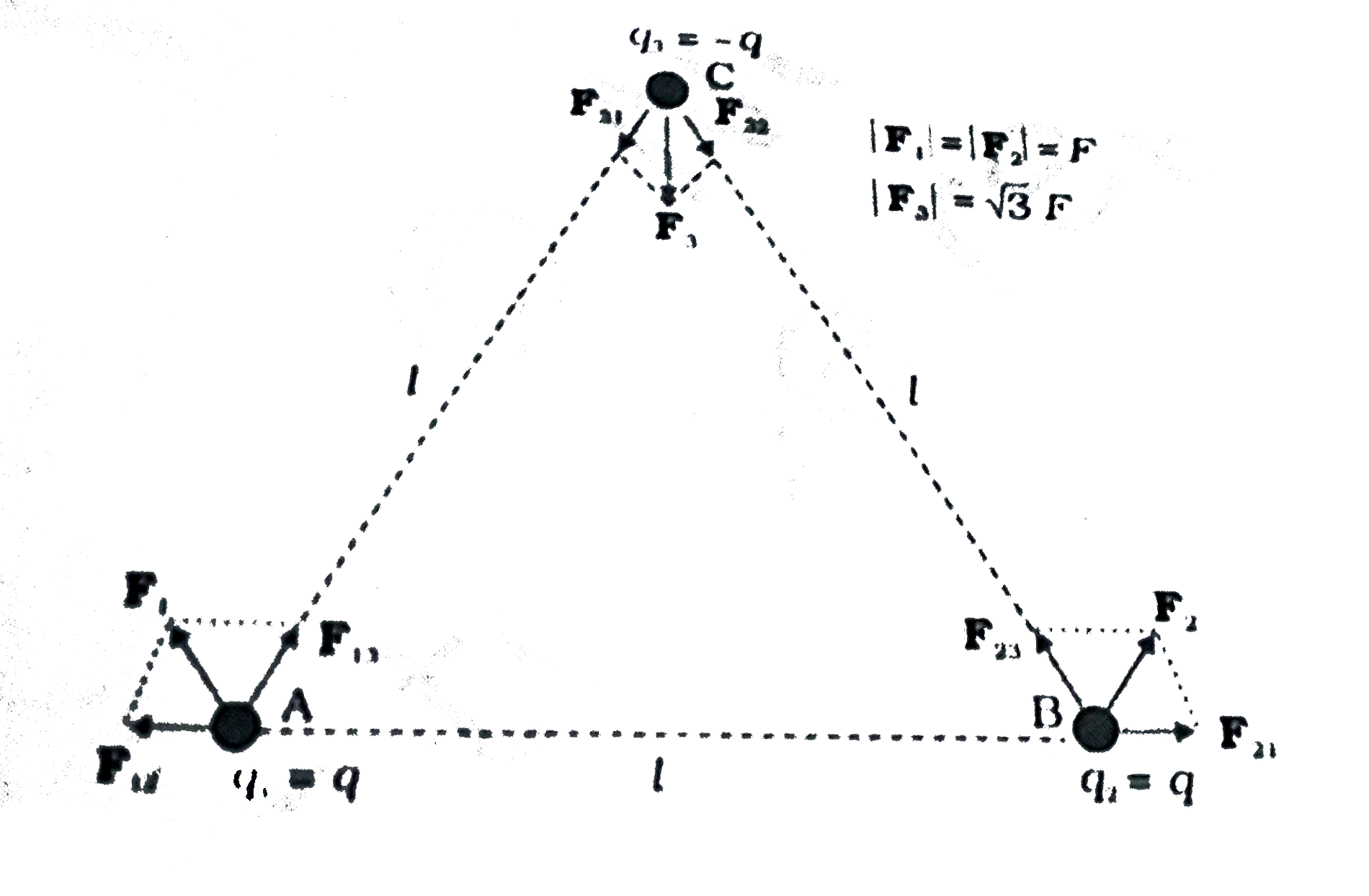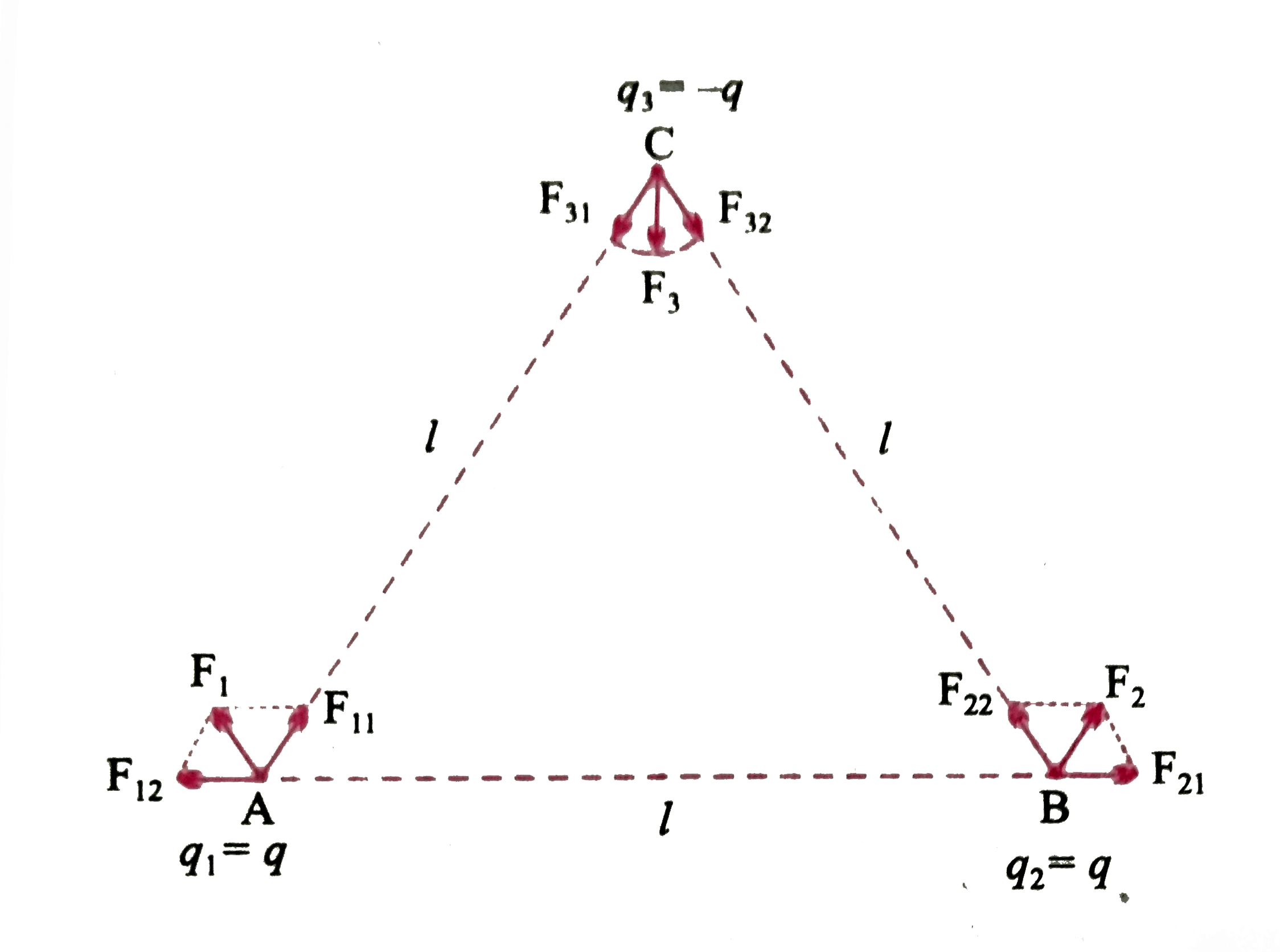Consider the charge q, q and -q placed at the vertices of an equilateral triangle, as shown in fig. What is the force on each charge?
 Solution in Telugu
Solution in Telugu
The forces acting on charge q at A due to charges q at B and -q at C are F12 along BA and F13 along AC respectively, as shown in Fig. By the parallelogram law, the total force F1 on the charge q at A is given by
F1=Fˆr1 where ˆr1 is a unit vector along BC.
The force of attraction or repulsion for each pair of chrages has the same magnitude
F=q24πε0l2
The total force F2 on charge q at B is thus F2=Fˆr2, where ˆr2 is a unit vector along AC.
similarly the total force on charge -q at C is F3=√3Fˆn, where ˆn is the vector along the direction bisecting the ∠BCA.
It is interesting to see that the sum of the forces on the three charges is zero, i.e.,
F1+F2+F3=0
The result is not at all surprising. It follows straight from the fact that Coulomb's law is consistent with Newton's third law. The proof is left to you as an exercise.
Topper's Solved these Questions
- ELECTRIC CHARGES AND FIELDSBOOK - VIKRAM PUBLICATION ( ANDHRA PUBLICATION)CHAPTER - ELECTRIC CHARGES AND FIELDSEXERCISE - VERY SHORT ANSWER QUESTIONS
13 Videos
- ELECTRIC CHARGES AND FIELDSBOOK - VIKRAM PUBLICATION ( ANDHRA PUBLICATION)CHAPTER - ELECTRIC CHARGES AND FIELDSEXERCISE - SHORT ANSWER QUESTIONS
6 Videos
- DUAL NATURE OF RADIATION AND MATTERBOOK - VIKRAM PUBLICATION ( ANDHRA PUBLICATION)CHAPTER - DUAL NATURE OF RADIATION AND MATTEREXERCISE - DAM SURE (VSAQ)
2 Videos
- ELECTROMAGNETIC INDUCTION BOOK - VIKRAM PUBLICATION ( ANDHRA PUBLICATION)CHAPTER - ELECTROMAGNETIC INDUCTION EXERCISE - Additional EXERCISES
15 Videos
Similar Questions
What is meant by the statement 'charge is quantized' ?
View SolutionState and explain Coulomb's incerse square law in electricity.
View SolutionThe wavelength of electromagnetic radiation is doubled. What will happen to the energy of the photons of the new radiation ?
View SolutionSuppose the loop in Textual Exercise 4 is stationary but the current feeding the electromagnet that produces the magnetic field is gradually reduced so that the field decreases from its initial value of 0.3 T at the rate of 0.02Ts−1 .If the cut is joined and the loop has a resistance of 1.6Ω how much power is dissipated by the loop as heat ? What is the source of this power ?
View SolutionConsider the charges q,q and -q placed at the vertices of an equilateral triangle of each side l. What is the force on each charge ?
View Solutionचित्र 1.10 में दर्शाए अनुसार किसी समबाहु त्रिभुज के शीर्षो पर स्थिर आवेशों q, q, तथा q पर विचार कीजिये । प्रत्येक आवेश पर कितन बल लग रहा है?

View Solutionचित्र के अनुसार किसी समबाहु त्रिभुज के शीर्षों पर स्थित आवेशों q, q तथा −q है। प्रत्येक आवेश पर लगने वाले बल की गणना कीजिए ।

View SolutionConsider three charges q1,q2 and q3 each equal to q at the vertices of an equilateral triangle of side 'l' what is the force on any charge due to remaining charges.
View SolutionThree charges are placed at the vertices of an equilateral triangle of side l. Each of the charges is q. Find out the force on a charge Q placed at the center of mass of the triangle.
View SolutionConsider three charges q_1,q_2,q_3 each equal to q at the vertices of an equilateral triangle of side l. what is the force on a charges Q ( with the same sign as q) placed at the centroid of the triangle,as shown in figure?
View SolutionConsider the charges q,q and -q placed at the vertices of an equilateral triangle what is the force on each charge
View SolutionConsider the charges q, q and -q placed at vertices of an equilateral triangle as shown it figure. What is the force on each charge ?
View Solutionविचार कीजिए कि l भुजा के किसी समबाहु त्रिभुज के शीर्षो पर आवेश q,q एवं −q स्थिर है आवेशों के निकाय पर बल है -
View Solutionसमान परिमाण q के तीन आवेशों को l भुजा वाले किसी समबाहु त्रिभुज के शीर्षो पर रखा गया है त्रिभुज के केन्द्र पर स्थित आवेश Q पर बल होगा,
View SolutionConsider the charges q, q and -q placed at vertices of an equilateral triangle as shown it figure. What is the force on each charge ?
View Solution
